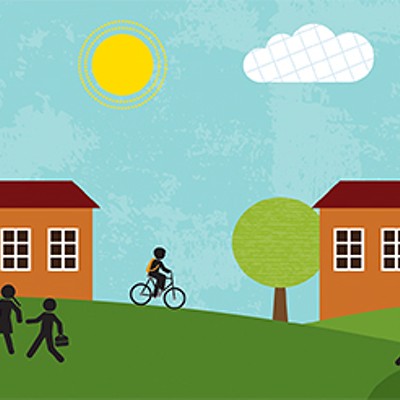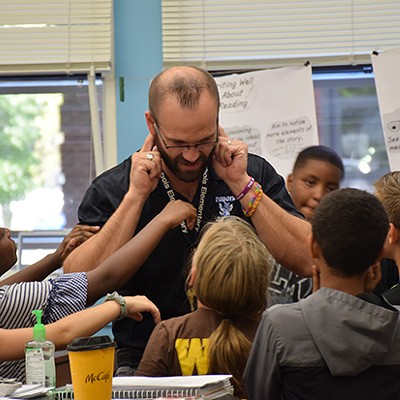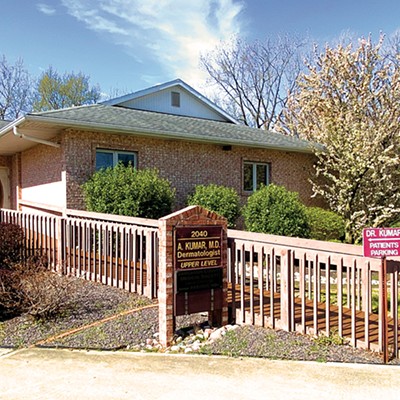School of hard knocks
More poor and homeless kids strain the public-education system
[
{
"name": "Air - MedRect Combo - Inline Content 1",
"component": "11490391",
"insertPoint": "3",
"requiredCountToDisplay": "1",
"parentWrapperClass": "fdn-ads-inline-content-block"
},{
"name": "Air - MedRect Combo - Inline Content 2",
"component": "11490392",
"insertPoint": "7",
"requiredCountToDisplay": "5",
"parentWrapperClass": "fdn-ads-inline-content-block"
},{
"name": "Air - MedRect Combo - Inline Content 3",
"component": "11490393",
"insertPoint": "12",
"requiredCountToDisplay": "9",
"parentWrapperClass": "fdn-ads-inline-content-block"
}
]
A mother at a Springfield mission is pleased
with her four children’s experiences in the local schools.
“Oh yeah, they like school. Oh yeah, the teachers are
good,” she says. Her children are making friends, and
although they could ride the bus, she walks with them most days.
Living at the mission, she has “more time to interact,
homework-wise,” she says. “It’s a lot easier to
be with them at the mission. I’m with them more time than I
was before.”
This woman’s children are among the
roughly 210 homeless children in Springfield public schools this
year, says Peggy Cormeny, homeless liaison for District 186.
Most children in transition are in
Springfield, but a few are scattered among other Sangamon County
communities. The schools rely on shelters to notify them of the
presence of school-age children, Cormeny says. Principals,
teachers, and secretaries are also responsible for identifying
homeless pupils — for instance, a child in their care might
remark, “We had to leave our house.” Staffers at the
Sojourn Women’s Shelter helped a mom and her teenage daughter
set up a time to register at Southeast High after the two moved to
Springfield.
Faith Sanderson, homeless-education liaison in
the Sangamon County Regional Office of Education, recently obtained
rental and utility assistance for a family in Riverton. Sick for a
long time, the father was unable to work, and the family had fallen
behind on their bills. However, a family must have exhausted all
other resources before asking the schools for such help. Federal
grants provide the schools with the money. Schools also connect
at-risk families with resources to help them before they become
homeless.
According to federal law, schools must enroll
homeless pupils immediately and deal with enrollment requirements
later. The liaisons help families obtain the children’s
medical records for enrollment and birth certificates so that they
can move into public housing.
Sanderson says that every school district must
identify homeless pupils and “remove barriers to educational
success.” Determining who is homeless, she says, depends
partly on the “permanency and adequacy of their
situation,” on a child’s or family’s reason for
leaving their home, and on the length of time they are in
transition. “It’s necessary to get the whole
story,” Sanderson says. “For instance, if a family is
living with relatives, how physically and financially comfortable
is the arrangement?”
“If you don’t have a home, school
is not at the top of your list,” Cormeny says. In a life
filled with uncertainty, though, school is a place of safety,
according to the Illinois Board of Education’s Opening Doors
Project, which helps homeless children and youth get educated.
Something as simple as a desk to call her own can provide a homeless
child with a sense of routine and ownership. In addition to living in
shelters and with relatives, a lot of families live in motels,
especially if they have a bad utility history, Cormeny says.
“Some people don’t understand they
are homeless,” Sanderson says. They may have been evicted and
begun living with a relative. Many people are out of their homes as
a result of house fires. “If kids can’t sleep at night
because they are cold, or they’re not getting fed, how are
they going to perform in school the next day?” Cormeny asks, recalling
families living in cars, a boy living in a tent out in the county.
Many teens do not have adult supervision,
Cormeny says: “Nobody is their guardian.” These kids
often wind up “couch-surfing” — moving around,
sleeping on relatives’ or friends’ couches. They are
afraid that if they are referred to the Youth Services Bureau, the
Department of Children and Family Services will put them in foster
care.
A University of Illinois at Chicago study
released in December identified 25,000 unaccompanied youths ages 12
to 17 in Illinois. The main causes of homelessness among
unaccompanied youth are physical and sexual abuse by a parent or
guardian, neglect, parental substance abuse, and family conflict,
according to Opening Doors.
The number of people living in poverty and the
ranks of the homeless are both on the increase. “Things are
getting worse for families,” Sanderson says. Some adults work
at low-paying jobs, such as food service, that come and go and are
subject to fluctuations in hours. When someone loses a job, it
could take weeks to find another one.
In Sangamon County in 2005, a person had to
earn $11.13 an hour to afford a two-bedroom apartment, says the
National Low Income Housing Coalition.
“People can hardly earn enough,”
Sanderson says. According to the Heartland Alliance, in 2005
Illinois was the least affordable Midwestern state for renters and
had the highest poverty rate while being the second wealthiest
state.
“Families have lives where they
can’t stay in one place,” Cormeny says. She worked with
a mother and two children who stay with one friend for a few days and then go to
another friend’s or relative’s home for another few days,
repeating this pattern so that the people she stays with do not lose
their lease for having too many people living in their apartment. The
mother could not afford her own housing.
Sanderson is concerned about the 22 percent
increase over three years in the number of children receiving free
or reduced-fee school lunches. In Sangamon County, 43 percent of
children qualify, according to the advocacy group Voices for
Illinois Children. These kids are likely to have experienced
homelessness or are “one crisis away from
homelessness,” Sanderson says.
Many homeless children have divorced or unwed
parents or parents who, Cormeny says, “made bad
choices.” She believes that the best way for a child to break
the cycle is to stay in school, get a high-school diploma, and go
to college. Although she hopes to see a family that gets a house
stay put, she recognizes that for some people, “owning seems
so foreign.”
The homeless liaisons build relationships with
families to get the parents into the schools and involved in their
children’s education. “Parent and family involvement is
very important,” Cormeny says. She believes that children in
transition are among those at risk for academic failure because
many have moved around or missed school. Studies show that a child
loses three to six months academically after changing schools.
Several programs are under way to provide
tutoring for homeless kids; for instance, Contact Ministries held a
four-week program last summer, and the Boys & Girls Club
provides after-school tutoring. “We are trying to get a
program at Sojourn,” Sanderson says. To get children involved
in extracurricular activities, schools waive the fees these
activities usually require.
Although the schools give pupils bus passes
and parents money for cabs to pick up their children, a pilot
program is being tried at several schools in which children, should
their families choose, would take special buses to their old
schools rather having to transfer to new schools on moving.
Districts within Sangamon County share transportation costs when a
child moves from one to another.
Six years ago, Sanderson recalls, one mother
finally caught on that it’s not good for a child to change
schools. Now, every time she moves, she calls to get transportation
for her child.
The outlook for homeless families is bleak,
but they are not without help.
Illinois Times has provided readers with independent journalism for almost 50 years, from news and politics to arts and culture.
Your support will help cover the costs of editorial content published each week. Without local news organizations, we would be less informed about the issues that affect our community..
Got something to say?
Send a letter to the editor and we'll publish your feedback in print!




















